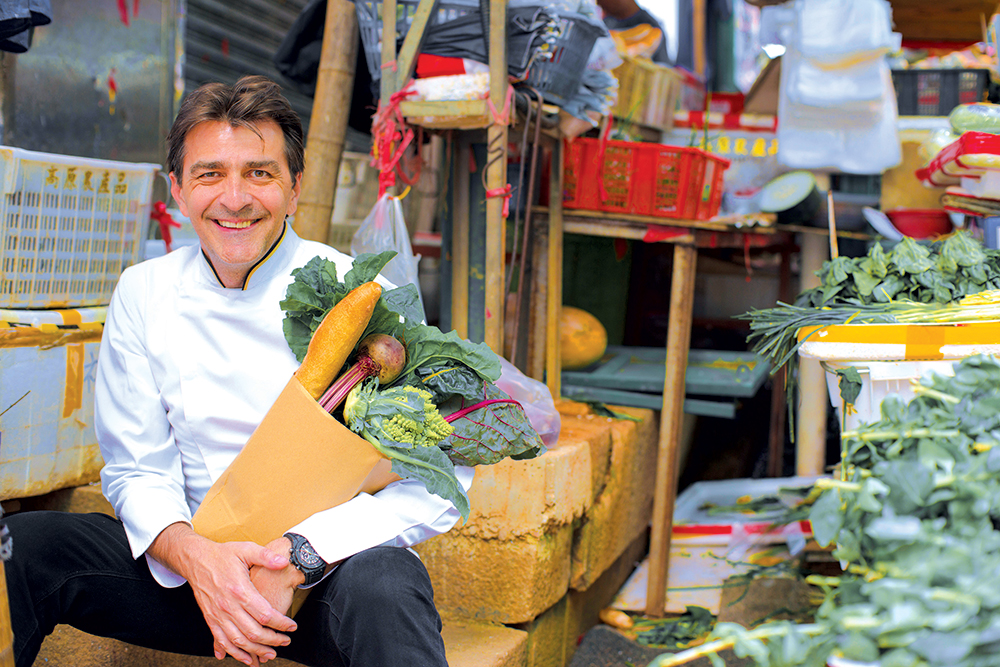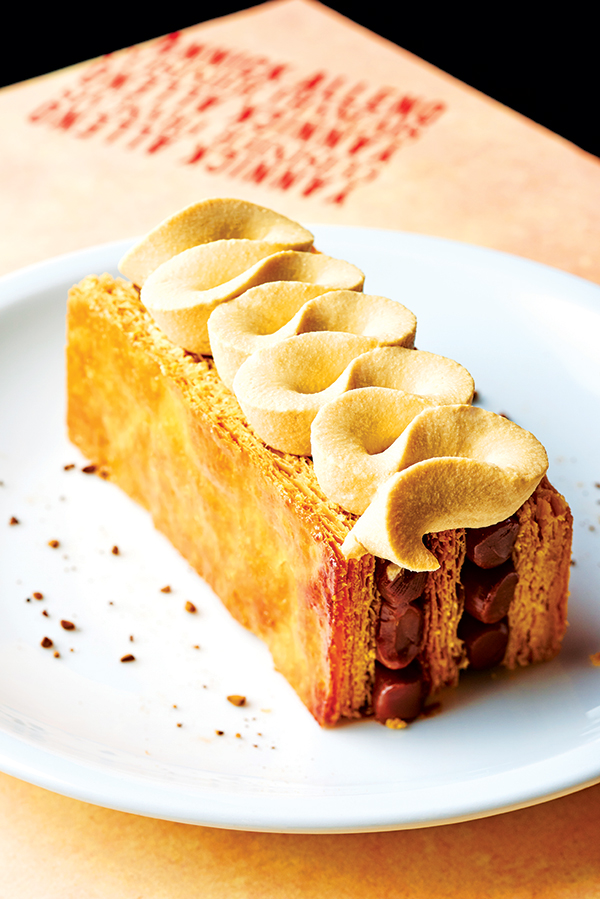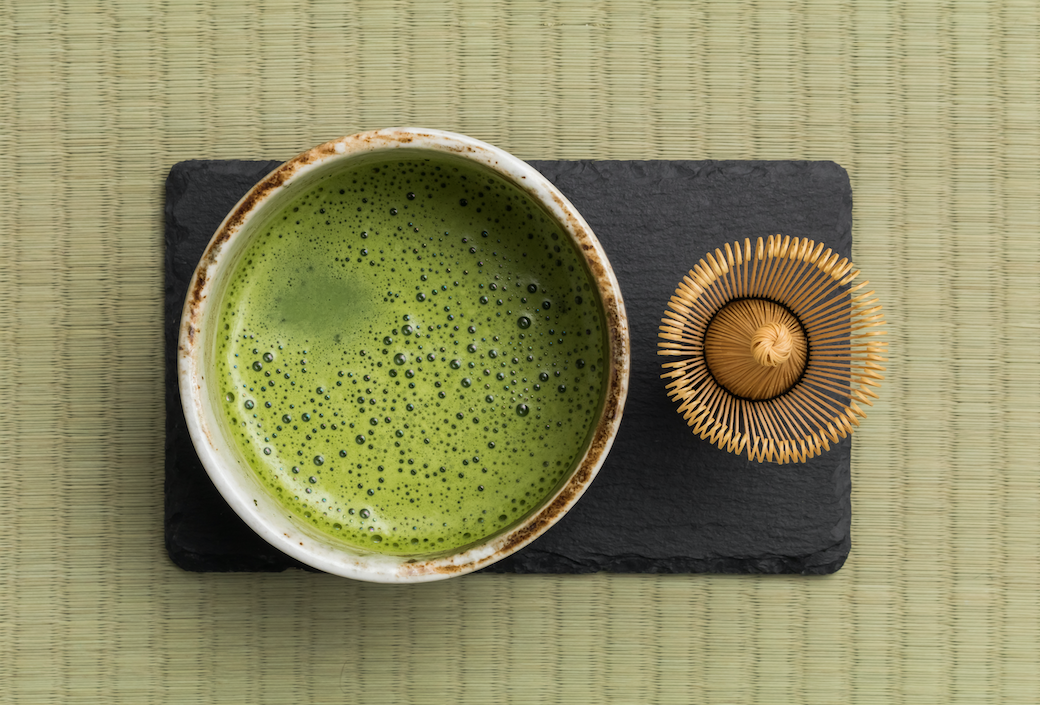
You may be familiar with chefs Alain Ducasse, Pierre Gagnaire and Joël Robuchon, and the food empires they’ve built. Unless you’re a gastronome, you’re probably less well acquainted with Yannick Alléno. The French chef is a visionary. Alléno’s restaurant, Le 1947, in the Cheval Blanc hotel in the French Alpine resort Courchevel, claimed a third Michelin star this year and he is soon to bring his Terroir Parisien restaurant to Hong Kong from Paris. Alléno spoke about what he learned from the winners of the Meilleurs Ouvriers de France competition for craftsmen, how his passion for sauces resulted in Extractions – a trademarked line of sauces – and his favourite dish, Robuchon’s hot foie gras soup with poultry aspic.
You learned from culinary masters. Tell us a little about how each of your teachers shaped the way you cook.
I started my training at the age of 15, learning from Manuel Martinez, Jacky Fréon, Gabriel Biscay, Roland Durand, Martial Enguehard and Louis Grondard. They were all Meilleurs Ouvriers de France and, consequently, classic French cuisine, excellence and rigour ruled the first 25 years of my career. Each of them had a style but they all had the same demanding nature towards taste, with huge knowledge and a fabulous will to pass on their expertise. I owe them everything. No wonder I am so into sauces today; they were all great masters of that. Still, the cuisine I am doing today is quite different from the one I learned. It is very personal, more modern.
You wrote a book devoted entirely to research into sauces. Why is sauce so important?
To me, sauces are part of our gastronomy’s DNA, its founding pillar. They are the link between all the elements on a plate and 80 per cent of a dish’s interest comes from the sauce featured in it. I am used to saying sauce is the verb of French cuisine. Try and build an interesting sentence without a verb. Impressive chefs such as François-Pierre de la Varenne, Auguste Escoffier or, more recently, Alain Chapel have all sung the praises of sauce. I am not saying this is the only solution to French cuisine evolution but it is my answer, and I am excited that many chefs have understood its importance. At last we are done with the dots and lines of olive oil, which I also did once upon a time, by the way.

What motivated you to create your versions?
When I left the famous Parisian palace I had been serving for 10 years, in 2013, I started travelling around the world, for I thought it was the way for me to find new inspiration. The more I travelled, the more I understood that the solution I was searching for would only come from France – what constitutes its essence and, therefore, sauces – and not from abroad. Actually, when you look at it, everything is a sauce. A consommé is a kind of clarified sauce. A simple ice-cream is made of a crème anglaise. A chocolate ganache is a sauce. Everywhere you find taste, you find sauce. That is when I became so passionate about finding the perfect distillates of flavour using modern techniques and why my research resulted in a collection of juices that are known as Extractions.
Describe your sauces to someone that hasn’t tasted them before. On the Internet, there are videos that show you drinking sauces out of a wine glass. Are they comparable to wines?
There is a real departure from the sauces as we’ve known them since antiquity. Before, to make a sauce, one would put many ingredients together with some grease and, under intense heat, wait until it reduced. Now we cook each and every ingredient separately at the right temperature, without any addition, and then reduce it by freezing it to obtain an extraction of the ingredient. To create the sauce, we blend several Extractions together until we find the perfect, most tasty combination. The result is a sauce less greasy, less salty and more digestible. The benefit of that method is huge, as the taste of each Extraction is phenomenal. That is why we offer guests to try it in wine glasses, so they can better understand the difference. To answer the last part of the question, yes. French chefs have developed sauces with a complexity that – in a way, in my opinion – echo the complexity of wine.

Terroir Parisien is a special project for you. Your family ran a bistro and this restaurant concept was born out of two years of research.Tell us about the process of saving France’s agricultural heritage.
Food is a family tradition. My parents used to manage bistros in the Parisian suburbs, so I was reared in this convivial and friendly ambiance of the neighbourhood restaurant. Paris is my land and, in 2006, I realised that we were all unaware of the richness of our terroir. I started researching it and found that we had hundreds of fabulous native Parisian varieties under our nose and that, unfortunately, they were close to disappearing. That is when I became deeply involved in saving this heritage. Two years of work started, referencing all the producers, their products and the region’s recipes. Our goal was to find quality farmers – and these were the last of them – who had kept the original and untouched seeds of the authentic cabbage from Pontoise, asparagus from Argenteuil, saffron from Gâtinais, peppermint from Milly-la-Forêt, peaches from Montreuil, artichoke from Paris, spinach from Viroflay and many more. In 2008, we created a great menu for the three-star restaurant I used to operate. In 2010, we published our first eponymous book and, in 2012, opened our first dedicated bistro. I am very happy that more than 130 chefs in Paris source locally, using the fabulous produce and making the whole virtuous process work. Terroir Parisien is an amazing adventure, one I am very proud of.
It’s been 10 years since you started the research. How far have you come and how much more is there to do?
There is always more and we can always do better. When you look at Massimo Bottura, Kamilla Seidler or Ron Finley’s initiatives – to name only a few – you understand the tremendous energy involved in making things change. We have to be conscious of the world we live in and respectful of what nature offers us, especially in restaurants. I am deeply committed to reducing our food waste and doing complete justice to the produce when cooking, for example.
Hong Kong is the second place where you’ve opened Terroir Parisien. How will you execute the process here? Will the restaurant serve all-French produce?
Terroir Parisien Hong Kong will be opening in the heart of Central, in Landmark, Prince’s Building. Actually, this is the first time Terroir Parisien has left its Parisian base for Asia and we chose Hong Kong. It’s a fantastic location and our bistro will be joining some of the world’s most fabulous brands, so we’re in good company. We will feature our Parisian casual cuisine and have recreated the original Wilmotte design there, reflecting the original location’s warmth and friendly atmosphere. I like to say that we are bringing a little bit of Paris to the heart of this Asian megacity. Our initiative promotes local sourcing. It would be more than a little insane to import everything from Paris. We will mainly focus on offering our classic Parisian recipes. We’ll use the best produce that we have carefully curated and sourced and, of course, we will be importing some specific Parisian produce that simply cannot be left out.

We can expect the same menu as in the original Terroir Parisien?
Terroir Parisien is a real French bistro. Our idea is to share our traditional casual food, which can sometimes be comfort food. Guests will be able to share the authentic croque-monsieur or our made-in-France pâtés, sample some of our signature dishes such as classic Paris mushrooms au gratin, stuffed with snails and a mix of shallots, parsley, watercress and garlic butter that we serve them upside-down as delicious mouthfuls you can grab with your fingers; or our trademark thick piece of pan-seared Charolais beef tenderloin with Bercy sauce; our lamb stew and spring vegetables in a casserole; and, as a dessert, my favourite is the Nanterre brioche French toast with vanilla ice-cream.
Having revolutionised the way we think of sauces, what’s next?
We are thinking of many projects currently. Some will take more time than others, and some are still quite confidential, I’m afraid. We’ll have to wait a little until we can actually talk about them, but we are working on a new book from our Reflections of a Chef collection, the one already featuring sauces and terroir. What I can tell you is we are super-happy to be opening a new Terroir Parisien bistro in Shanghai at the end of the year and another one in Paris at the beginning of next year.

What was your most memorable meal? Who did you dine with and what did you have?
Without a shadow of a doubt, it was Joël Robuchon’s soupe chaude de foie gras à la gelée de poule at Jamin, his former three-star restaurant. It was a long time ago, as it has been closed for more than 20 years, but the memory I have of this dish is so powerful. That is the magic of cuisine.
You’ve cooked for many people, including top chefs. Who did you find hardest to please?
The most difficult person to please is my everyday client. Everyone is treated with the same attention to their demands, as my only goal is for him or her to come back. It makes no difference to me who he or she is, and I am always trying my best in every dish served.





